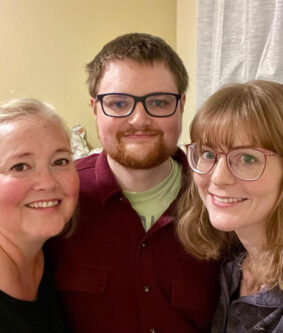Chronic pain complicates quality of life for local family
By Cal Braid - Lethbridge Herald Local Journalism Initiative Reporter on October 29, 2022.
 Submitted photo
Siblings Penny Kowalchuk, Tekoa Eshleman, and Kasee MacDonald all struggle with the pain of EDS, a genetic health condition that can cause differing symptoms in individuals.
Submitted photo
Siblings Penny Kowalchuk, Tekoa Eshleman, and Kasee MacDonald all struggle with the pain of EDS, a genetic health condition that can cause differing symptoms in individuals.Health Canada estimates that nearly eight million Canadians live with chronic pain. That’s about 20 per cent of the population, and that means that you or someone you know has been affected by it. Someone you know is likely dealing with it as you’re reading this.
Lethbridge resident Penny Kowalchuk knows all about chronic pain. It’s not a matter of poor lifestyle choices, a degenerative condition, or injuries; it’s a genetic predisposition. Most of her family has been diagnosed with hypermobile Ehlers-Danlos Syndrome (EDS), a genetic connective tissue disorder that can affect multiple systems of the body. A person can be affected by the same disorder in different ways.
She shares a house with her dad and younger brother, Don and Tekoa Eshleman. Her younger sister Kasee MacDonald is married and lives nearby. They all deal with pain daily. Penny said that she didn’t have chronic pain until she was in her late 30s, but her siblings developed it much earlier.
Penny said that doctors find chronic pain “very complex and difficult to deal with. I think the key to it is to find a doctor who listens and is willing to work with you, either a family doctor or a pain doctor. I’ve had both who were good. You can’t cure it, so the best thing is finding a way to manage it.”
Younger sister Kasee described her main symptom as overall chronic pain, in addition to joint hyper-mobility and nerve pain. She said that lot of the pain comes from injuries to the joints in her hips, wrists, ankles, and elbows. “Every joint,” she said. She said she doesn’t have a lot of internal injuries like hernias, which are also common to EDS patients. Asked how she would differentiate between nerve pain and other pain, Kasee gave a short laugh and said, “You gotta feel it I guess.” Her best description for nerve pain was, “a stabbing sharp pain like lightning, or tingling if it’s not as severe.”
Brother Tekoa suffers more from internal micro and macro-tears, and said, “I’ve had hernias every year of my life since I was 13.” Penny noted that one of the disturbing aspects of the condition is that “You may be able to do stuff one day, but if you’re too active then you can be completely bedridden for two days or longer, depending on how hard you do stuff. You cannot move. It’s not that you don’t want to get out of bed; you can’t get out of bed. You just lay there. If you have to go to the bathroom you have to crawl to get there.”
The genetic component cannot be overstated and Kasee said, “It’s a dominant gene, so if you have kids there’s a 50/50 chance that they’ll have it. My dad has seven kids and all seven kids have it.” Tekoa wisecracked, “We’re bad at gambling.”
Penny added, “The geneticist told us that it waxes and wanes, so you can have good periods and bad periods and sometimes they can be years long or months long and you just don’t know what to expect. It’s like a monster lurking around the corner waiting to get you.”
Kasee said, “This type isn’t considered degenerative, but if you think about it, as you get older your body is less able to heal.” While a diagnosis is a starting point for legitimizing a person’s pain and hopefully connecting them with adequate medical care, a larger question looms: What happens to the individual’s quality of life and what limitations are imposed upon them because of this?
“If it’s well managed, you can have a pretty good quality of life,” Penny said. “You have to adjust your expectations. I try to use the time that I have in some productive way like looking after my family or working with (advocacy support group) Help Alberta. It’s something I can do on the days that my mind can focus on it.”
If given the opportunity, Kasee said, “I’d love to go back to school, but you have to choose. I can’t do both. If I was a normal 28-year-old I could do night school and work during the day but there’s just no way. You use the energy that you have on a number of things and then you have to sacrifice the rest. You have to adjust your expectations and figure out what’s most important. For me having kids right now is a virtual impossibility.” Penny admitted that she also really wanted to have children and being unable to “was another kind of a death.”
So, if one’s quality of life is affected, is depression an inevitable by-product of persistent, debilitating pain? It largely depends on how well the pain is managed. Kasee said, “Tekoa can’t get the meds he needs so he has no quality of life.” Penny added, “He’s trapped in bed 90 per cent of the day, so that causes depression of course.” Kasee on the other hand has “an awesome doctor, so I get to have some quality of life.” She said she doesn’t often get depressed, but that some days she’s an emotional wreck because the pain wears at her.
Like many others living with unrelenting pain, they seek relief and occupy themselves with getting through it as best they can. Kasee credits her spirituality as a flame of hope in the darkness of pain.
“I would probably be worse if I didn’t have hope that God had a plan for my future, even if I can’t do it on my own.” Penny is a giver, and said, “For me, it’s helping other people as much as I can that gives me meaning and makes my life feel productive.”
15-14




